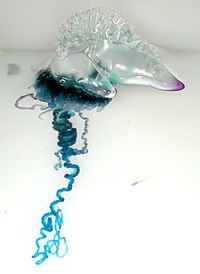
Photo from wikipedia
Type of funding sources: None. Acute Physiologic and Chronic Health Evaluation (APACHE), Sequential (sepsis-related) Organ Failure Assessment (SOFA) and Simplified Acute Physiologic Score-2 (SAPS-2) are common predictive scoring systems in… Click to show full abstract
Type of funding sources: None. Acute Physiologic and Chronic Health Evaluation (APACHE), Sequential (sepsis-related) Organ Failure Assessment (SOFA) and Simplified Acute Physiologic Score-2 (SAPS-2) are common predictive scoring systems in the intensive care unit (ICU) used all around the world to predict outcomes in general or specific population (eg. sepsis and septic shock). However, these scores were found to have mixed performance in several subgroups of critically ill patients. Few and conflicting data are available on patients admitted in the ICU after an out-of-hospital cardiac arrest (OHCA) regarding these prognostic scores. We sought to evaluate the performance of these scores obtained on admission in predicting good neurological outcome at ICU discharge. We enrolled 171 consecutive patients admitted to ICU at our center after being resuscitated from an OHCA from September 2017 to April 2021. APACHE, SOFA and SAPS-2 were available for 133 patients [77% male, mean age 60 (18-90) years, 54% with first shockable rhythm, median number of shocks delivered 1 (0-14), median value of adrenaline administered 3 mg (0-12), 26% received amiodarone, median cardiac arrest duration 38 min (IQR 22-74)]. Worst values collected during the first 24 hours were considered for APACHE and SAPS-2 calculations, whereas SOFA was assessed at 24 hours from admission. The median values of each one of the three scores of patients with and without good neurological outcome (cognitive performance category 1-2) at ICU discharge were compared with Mann-Whitney U-test. For each one of the scores the Receiver Operating Characteristic (ROC) curve was analysed and the corresponding area under the curve AUC with its 95%CI was calculated, with the endpoint of survival with good neurological outcome at ICU discharge. patients with good neurological outcome had lower values of APACHE [22 (IQR 19-25) vs 24 (IQR 21-28)(p=0.01], SOFA [9 (IQR 7-10) vs 10 (IQR 8-12)(p<0.01] and SAPS-2 [56 (IQR 44-64) vs 72 (IQR 61-83)(p<0.01] . APACHE and SOFA scores showed similar AUC [0.616 (95% CI 0.528-0.699) vs 0.652 (95%CI 0,564-0,732), p=0.54]. SAPS-2 score performed significantly better than the other two [AUC 0.784 (95% CI 0.705-0.851, p<0.0001)]. SAPS-2 score discriminates survival with good neurological outcome at ICU discharge significantly better than APACHE and SOFA in patients resuscitated from an OHCA and admitted to the ICU. These results could help clinicians in identifying which patients yield a better prognosis after 24 hours of clinical observation in the ICU and could therefore be safely and rapidly discharged to the ward.
Journal Title: European Heart Journal: Acute Cardiovascular Care
Year Published: 2023
Link to full text (if available)
Share on Social Media: Sign Up to like & get
recommendations!